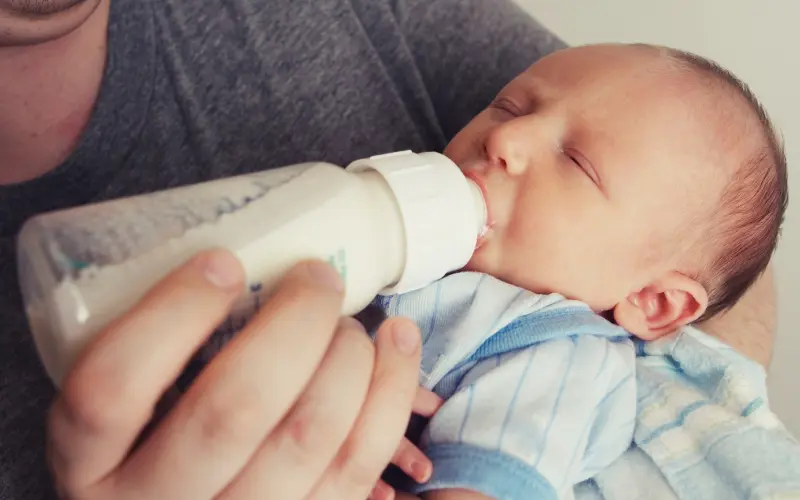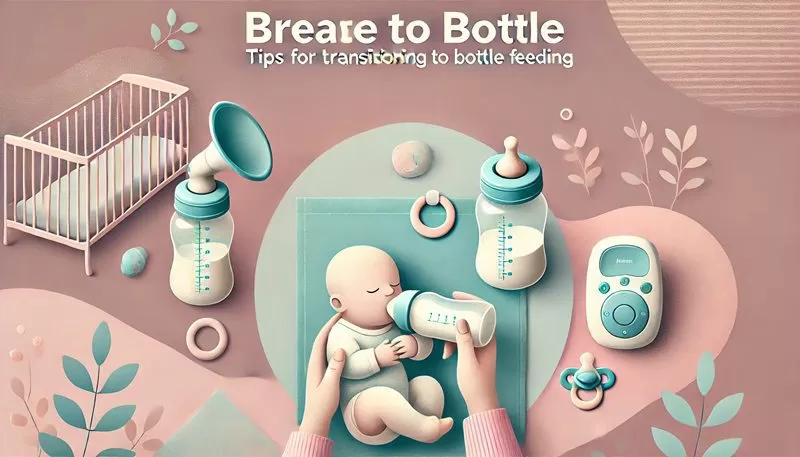Table of Contents
Transitioning to Bottle Feeding
Transitioning your baby from breastfeeding to bottle feeding can be a challenging time for both parents and babies. Whether you’re introducing formula or expressed breast milk, the process requires patience, consistency, and a few practical tips to make the switch as smooth as possible. In this guide, we’ll explore how to transition from breastfeeding to bottle feeding while recommending some essential products from [your store] to help you along the way. Let’s dive into how to transition from breastmilk to formula, along with some of the best methods for a hassle-free experience.
Transitioning from breastfeeding to bottle feeding can be a challenging process for many parents. It’s essential to understand the proper techniques and tips to make the switch smoother for both the baby and the parents. For additional guidance on how to transition from breastfeeding to bottle feeding, this comprehensive guide offers expert advice on the topic and can be a valuable resource for those seeking more detailed information.
When Should You Start the Transition?

The right time to transition from breast to bottle feeding depends on several factors, including your baby’s needs and your personal schedule. Some parents introduce the bottle early, while others wait until breastfeeding is well-established. In general, waiting until your baby is at least 4-6 weeks old ensures they’ve mastered breastfeeding, making the switch to a bottle less disruptive.
Pro Tip: If you’re planning to return to work or need to introduce formula, start the process a few weeks in advance to give your baby time to adjust.
How to Transition From Breastmilk to Formula?

The process of switching from breastfeeding to formula can feel daunting, but it doesn’t have to be. It’s best to begin by introducing one bottle a day of either expressed breast milk or formula, gradually replacing breastfeeding sessions with bottles over time. This gradual approach allows your baby to get used to bottle feeding while still enjoying the comfort of breastfeeding.
Here’s a step-by-step guide to help with the transition:
- Introduce a familiar feeding bottle: Opt for a bottle with a nipple that mimics the shape and flow of your breast, such as our Natural Flow Baby Bottles. This helps reduce nipple confusion and makes the transition easier.
- Start with expressed milk: Before switching to formula, try giving your baby expressed breast milk in a bottle so they can adjust to the bottle without the added change of formula.
- Mix breastmilk and formula: If your baby is reluctant to drink formula, mix it with breast milk in the same bottle. Start with a ratio of 75% breast milk and 25% formula, then gradually increase the formula content. For easy mixing, our Formula Mixing Bottle ensures a smooth consistency without clumps.
The Best Ways to Transition from Breastfeeding to Formula

While some babies adapt quickly to bottles, others may resist the change. It’s important to be patient and persistent, as consistency is key to making the transition smoother. Below are some of the best ways to transition from breastfeeding to formula:
- Offer the bottle when your baby is calm: Introducing the bottle when your baby is hungry or upset can make the transition more difficult. Choose a calm moment for your baby’s first bottle-feeding experience.
- Use a slow-flow nipple: Using a slow-flow nipple like those on our Anti-Colic Bottles allows your baby to feed at a pace similar to breastfeeding, reducing frustration and preventing choking.
- Have someone else offer the bottle: Sometimes, babies may refuse the bottle if they associate it with their mother. If possible, have another caregiver introduce the bottle for the first few feedings.
Weaning Your Baby: Switching From Breast Milk to Formula

Weaning is a gradual process and an important milestone in your baby’s development. While some babies may take to formula quickly, others may require more time and patience. The key is to make the process as gentle as possible.
- Begin slowly: Start by replacing one breastfeeding session per day with a bottle of formula, such as Gentle Baby Formula, which is designed to be easy on your baby’s digestive system.
- Adjust the feeding schedule: Gradually increase the number of bottle-feedings while decreasing breastfeeding sessions. This gradual approach allows both you and your baby to adjust without discomfort or disruption.
- Stay patient: Every baby is different, and some may take longer to adjust. Don’t rush the process or become frustrated if things don’t go smoothly right away.
Tips for Success: How to Transition From Breastmilk to Formula?

Transitioning to formula requires patience and a flexible mindset. Some days may be easier than others, and that’s okay. Here are a few final tips to ensure success:
- Stick to a routine: Establish a consistent feeding schedule to help your baby know what to expect, making the transition smoother.
- Choose the right formula: Select a formula that’s gentle on your baby’s tummy. Our Organic Infant Formula is a great option for babies with sensitive stomachs and provides the essential nutrients they need to thrive.
- Comfort your baby: Transitioning from breastfeeding to bottle feeding can be emotional for both mom and baby. Ensure you’re providing plenty of cuddles and comfort during the process.
Common Challenges and How to Overcome Them
Even with the best preparation, transitioning from breast to bottle may not always go smoothly. Here are some common challenges and how to tackle them:
- Bottle refusal: If your baby is refusing the bottle, try offering it at a different time or in a new position. Sometimes, a simple change in environment or routine can make a big difference.
- Nipple confusion: If your baby is struggling to switch between breast and bottle, try using a nipple that closely resembles your own. Our Natural Flow Baby Bottles are designed to mimic the breastfeeding experience, reducing the chance of nipple confusion.
- Gas and colic: Some babies may experience gas or colic when switching to formula. Using an anti-colic bottle, like our Anti-Colic Bottles, can help reduce air intake and make feeding more comfortable for your little one.
The Best Ways to Transition from Breastfeeding to Formula Recap
As you work through the transition, remember that flexibility and patience are key. There’s no one-size-fits-all approach, but by following the steps outlined above, you can find the method that works best for you and your baby. Products like our Natural Flow Baby Bottles, Gentle Baby Formula, and Anti-Colic Bottles are designed to make the switch from breast to bottle as smooth and comfortable as possible.
Final Thoughts: Weaning Your Baby: Switching From Breast Milk to Formula
Weaning your baby from breastfeeding to formula is a big step, but with the right strategy and tools, it can be a positive experience for both you and your little one. By introducing the bottle gradually, using the right products, and being patient with the process, you’ll ensure that the transition is a smooth and stress-free one. Don’t forget to check out our collection of feeding essentials, including the Natural Flow Baby Bottles, Gentle Baby Formula, and Anti-Colic Bottles, all of which are designed to support you during this transition.
If you’re looking for more guidance on how to transition from breastmilk to formula, feel free to browse our blog for additional resources and expert tips. Remember, the best ways to transition from breastfeeding to formula will vary for each baby, but with the right approach, your baby will adjust in no time

